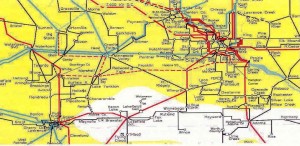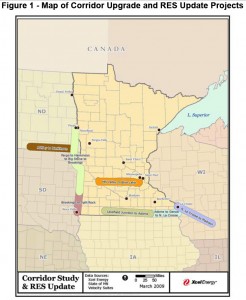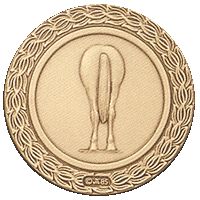Big Stone II transmission is DEAD
March 5th, 2010
This was in the mail — what a day this has been. I’ve been buried in other things and lost track of this one.
Big Stone II transmission connected into CapX.
The transmission study shows that BSII transmission needs CapX:
And the question remains — how much does CapX 2020 need BSII?
Thanks to a little birdie for bringing this PUC Order to my attention!!!
Big Stone is dead, dead, dead
November 2nd, 2009
Hot off the press from MDU — there’s contact info at the bottom.
DO SEND THEM CONDOLENCES AND A THANK YOU NOTE!!!
From MPR just now:
And a BSII Press Release found in the inbox:
November 2, 2009
Participating utilities announce wind-down of Big Stone II project
The participating utilities announced today that they will not build the Big Stone II Project, a planned 500-to-600-megawatt coal-fired power plant to be located near Milbank, South Dakota, and its associated transmission. The project required additional participants to move forward; however none have committed.
Big Stone II, a fully permitted project, had been determined to be the least-cost, environmentally sound baseload power plant for the project participants. The project’s high voltage transmission facilities were to be sized to also serve the region’s burgeoning wind energy development.
The Big Stone II Project participants were Central Minnesota Municipal Power Agency, Heartland Consumers Power District, Missouri River Energy Services and Montana-Dakota Utilities Co.
For information specific to each company, contact:
Mark Hanson, Montana-Dakota Utilities Co., 701-530-1093 or mark.hanson@mduresources.com.
Bill Radio, Missouri River Energy Services, 605-731-2522 or billr@mrenergy.com.
Russ Olson, Heartland Consumers Power District, 605-256-6536 or rolson@hcpd.com.
Lori Frisk-Thompson, Central Minnesota Municipal Power Agency, 507-526-2193 or lorift@cmmpa.org.
Big Stone II is zu ende???
September 11th, 2009
Otter Tail Power has withdrawn from Big Stone II. Odd way to put it because Big Stone II IS Otter Tail Power. OTP was the big one left in the game and now they’re gone.
Otter Tail Power has withdrawn from the Big Stone II coal plant. Really?!?!?
Pinch me, I must be dreaming…
Here’s their post about it on their BSII site – love the euphemisims:
Big Stone II announces participant changes
Otter Tail Power Company withdraws; Project pursues new participants
In the first blurb to come over the wire, below, there’s one phrase that stands out:
I knew that financing was not happening and dependent on a big cash infusion from Bill Gates. Financing anything now is pert near impossible, hence the big cost allocation dust up for CapX lately, and Big Stone II was no exception. Who on earth, who in their right mind, would invest in a coal plant today? That falls squarely in the “HOW STUPID CAN WE BE” category, no doubt about it.
I‘ll post more as it turns up. From Marketwatch:
Otter Tail Power Company Announces Withdrawal From Big Stone II
WOW’s deal with the devil at issue
August 18th, 2009
“Wind on the Wires” and AWEA are whining and crying in the press about unfair treatment to wind generators. They do a deal with the devil to promote transmission and now are getting screwed — sorry, I won’t be hosting a pity party here!
AWEA and WOW’s FERC filing to protest MISO cost allocation proposal
To look at the full FERC docket, GO HERE TO FERC SEARCH PAGE, and search for docket ER09-1431.
“Wind on the Wires” is a subset of the Izaak Walton League – Midwest, not a separate organization. Some background here:
Years ago, the Midwest Izaak Walton League, together with MCEA, ME3 (Fresh Energy) and North American Water Office, did a deal with Xcel, and a massive “Wind on the Wires” grant was announced a couple of days later. The deal was to support a massive transmission buildout, specifically, to work to change state and federal law; to support transmission projects; to usher them through the legislature, state and federal administrative venues, to support at industry transmission planning groups; to support changes in rate recovery; to support changes in transmission need and siting criteria; and to allow transmission-only companies, all the things that Xcel wanted to roll out CapX 2020, JCSP, and whatever else is in their dreams.
Really… it’s all here:
$8.1 Million Wind on Wires grant from McKnight/Energy Foundation
This 2003 Settlement Agreement was in the Minnesota PUC’s TRANSLink docket, where Xcel wanted a transmission only company, not yet allowed in Minnesota. For the docket, go to www.puc.state.mn.us and then click on “eDockets” and search for docket 02-2152. F”or the resulting legislation, some of it, see 2005 Transmission Omnibus Bill from Hell.
So they jump through all those hoops and where are they? What happens?
Back to Cost Allocation of Transmission.
Let’s see… there was one cost allocation scheme, 50-50 split between owner utilities and generators connecting. Otter Tail Power objected and so the utilities changed it to a 90-10 split, and now “Wind on the Wires” and AWEA are screaming, whining and crying saying it has to go back. This has to do with how the utilities characterize the purpose of the line, be it for “Reliability” or “Generation Interconnection” and how costs are apportioned are different. In the CapX proceeding, the “Brookings line” was not declared, and the Fargo and LaCrosse lines were deemed “Reliability” but that’s absurd…
For “Baseline Reliability” projects here’s the cost allocation scheme:
For “Generation Interconnection” here’s the cost allocation scheme:
Ummmmm… a little more background here now that we’re talking about interconnection… does anyone remember the name of that coal plant that Otter Tail Power just got permitted to build? Oh, yeah, right, it’s BIG STONE II. And what was the name of that big honkin’ coal plant that “suddenly decided” to produce electricity rather than syngas? South Heart, yeah, that’s it. See “South Heart coal gasification — Coal on the Wires.” Both plants strategically placed to use CapX 2020 transmission. So what is the impact of this shift to Otter Tail Power and their Big Stone II project?
Here’s the Big Stone electrical link to CapX — it’s all connected:
Here’s new connector ND transmission announced April 3 — it’s all connected:
And of course, the big picture of CapX 2020 – click on it for a bigger picture to really appreciate those lines starting in the Dakotas:
Here’s an article from last week about their objections:
Wind industry protesting plan to pay for new lines
Cost-sharing proposal decried as threat to renewable energy goals
By Leslie Brooks Suzukamo
lsuzukamo@pioneerpress.com
Updated: 08/14/2009 12:01:26 PM CDT
So if “Wind on the Wires” and AWEA object to “generator pays” transmission, where it’s the generator causing the need, then they’re now in essence advocating for a different scheme for Big Stone II and South Heart coal plants too. Oh, good idea…
Here’s another one that turned up — WOW and AWEA sent out a raft of press releasees…
Wind Industry Fights Midwest Transmission Proposal to Stay Alive
by Stacy Feldman – Aug 17th, 2009
Even worse — the plan could put the nation’s renewable energy goals in jeopardy.
Currently, generators and utilities split the price paid, 50-50.
And then there’s the big issue of cost: Who would pay for it?
The MISO proposal is a local version of that long-simmering cost dispute.
FERC has not indicated whether it favors MISO’s proposal or would recommend changes.
SD’s Sen. Thune sucks up to Big Stone II
February 3rd, 2009
Horses Ass Award for South Dakota’s Senator John Thune.
Has he no shame? Sen. John Thune fired off this letter to the EPA when it filed objections to the Big Stone II air permit. Whatever is he thinking? That the regulations don’t apply to his pet project, despite the obvious emissions problems?
Here’s the letter:
It has recently come to my attention that the Environmental Protection Agency (EPA) has issued some objections regarding the South Dakota Department of Environment and Natural Resources (DENR) desire to renew the operating permit for the existing Big Stone Power Plant in South Dakota. As a strong proponent of expanding our commitment to addressing our nation’s energy challenges, I am writing to inquire about your Agency’s recent action, as well as how this objection impacts the Big Stone II project.
As you know, the United States is the world’s largest electricity consumer and is expected to remain that way for decades to come. In the Upper Midwest, experts predict several thousand megawatts of generation capacity are needed to meet our region’s growing energy demands. In responding to this challenge, five electric utilities have proposed building a 500-580-megawatt, coal-fired electric generation plant. The new facility would be built next to the existing 450-megawatt Big Stone Power Plant, located near Big Stone City, South Dakota. Four of these partners (Otter Tail Power Company, Heartland Consumers Power District, Montana-Dakota Utilities Company and Missouri River Energy Services) provide electricity to thousands of my constituents throughout South Dakota, and more than one million people when you total their services to individuals and businesses in four other states.
While the addition of Big Stone II will more than double the plant’s generation capacity, it will also utilize new technologies so that emissions of sulfur dioxide, nitrogen oxides and mercury from the two plants will be cleaner than the current, single plant. Big Stone II is also expected to emit 20 percent less carbon dioxide than existing coal-fired power plants in the region. Since President Obama indicated his readiness to “invest in low emissions coal plants” within his New Energy for America plan, I trust the Administration will support the efforts of these dedicated individuals who have committed their work, time and money on this project to ensure the region will have safe, reliable and affordable energy in the future.
This project is also crucial to our region’s increased commitment to wind energy development. As a United States Senator, I have endeavored to promote the advancement of wind energy in order to grow South Dakota’s economy and help meet our nation’s growing energy demands. One significant impediment to increasing wind energy production is the lack of transmission lines available to transfer this harnessed product to markets in need. Transmission upgrades that coincide with the construction of Big Stone II will also provide opportunities for the expansion of renewable wind energy in the region.
While I appreciate that permitting procedures under the Clean Air Act can be very complex, I understand that the South Dakota DENR has 90 days to submit a revised permit that meets the objections raised by your Agency. I am confident that the participating utilities and DENR will provide sufficient adjustments to the permit so the project is completed in an environmentally responsible manner that provides the electrical power essential to the region. Despite the claims by some advocacy groups, I sincerely hope the last-minute list of objections by EPA is not an attempt to derail this important and needed project.
I believe there is great potential in this undertaking by the five participating utilities. I look forward to hearing about your Agency’s role in moving this project forward, as it is essential to promoting economic growth and meeting the region’s energy demands, including expanded wind generation.
Kindest regards,
John Thune
United States Senator













